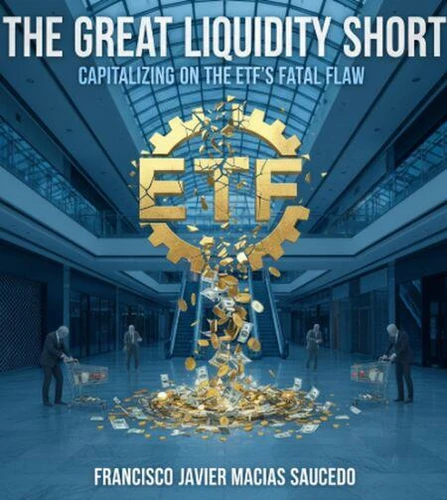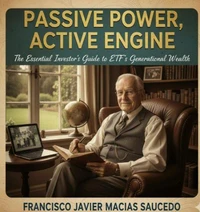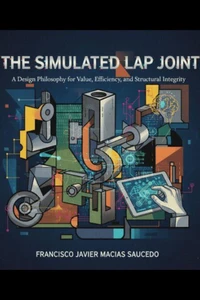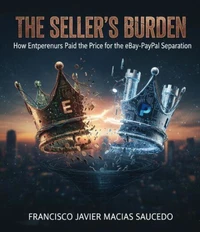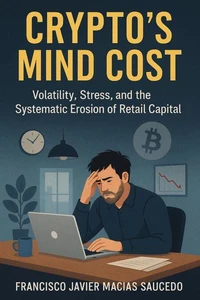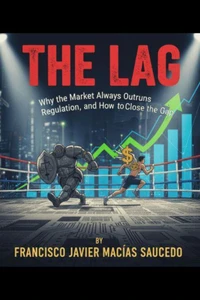Nouveauté
The Great Liquidity Short: Capitalizing on the ETF's Fatal Flaw
Par :Formats :
Disponible dans votre compte client Decitre ou Furet du Nord dès validation de votre commande. Le format ePub est :
- Compatible avec une lecture sur My Vivlio (smartphone, tablette, ordinateur)
- Compatible avec une lecture sur liseuses Vivlio
- Pour les liseuses autres que Vivlio, vous devez utiliser le logiciel Adobe Digital Edition. Non compatible avec la lecture sur les liseuses Kindle, Remarkable et Sony
 , qui est-ce ?
, qui est-ce ?Notre partenaire de plateforme de lecture numérique où vous retrouverez l'ensemble de vos ebooks gratuitement
Pour en savoir plus sur nos ebooks, consultez notre aide en ligne ici
- FormatePub
- ISBN8232127206
- EAN9798232127206
- Date de parution05/10/2025
- Protection num.pas de protection
- Infos supplémentairesepub
- ÉditeurHamza elmir
Résumé
The Exchange-Traded Fund (ETF) was hailed as the democratizer of wealth-a low-cost, diversified gateway to long-term investing. But what if this innovation is not a solution, but a profound systemic risk?This book exposes the core contradiction at the heart of the modern financial market: the ETF's hyper-liquidity, its greatest selling point, is actively subverting the very principles of prudent, long-term capital allocation. ?? The Psychological Trap of Instant Trading Originally designed for patient, passive indexing, the ETF's inherent daily tradability has turned it into a high-frequency trading instrument.
It transforms investing from a slow, methodical process into a fast-paced game, encouraging a regime of short-term, emotional decision-making-a stark departure from "set it and forget it." For the individual investor, the easy ability to buy and sell at any moment of the trading day is not a feature, but a psychological trap that erodes compounding returns and locks in losses through panic-driven selling. ?? The Engine of Systemic Instability The Perils of Hyper-Liquidity reveals the structural pathology where an ideal long-term vehicle is exploited for short-term speculation.
It argues that: The Middle Class is the Unwitting Underwriter: The collective capital and constant trading of retail investors provide the essential liquidity and market depth that the financial elite-institutional and high-net-worth traders-exploit for massive, predictable gains. The Debt is Packaged, Not Managed: By design, ETFs indiscriminately channel capital into a broad basket of assets, systematically aggregating and amplifying market-wide structural weaknesses, including unsustainable dividend yields, high debt loads, and speculative asset bubbles.
The Detachment of the Elite: Sophisticated investors operate with a detached calculus, valuing the tradability of the "signed paper"-the ETF share-over the tangible, long-term productive value of the underlying assets. The convenience and efficiency of the ETF have merely papered over a dangerous underlying assumption. This book is a vital wake-up call, showing how a structural flaw is turning a tool of diversification into an accelerant for speculative behavior, destined to culminate in a swift, dramatic correction.
The final section reveals how astute, risk-aware investors can recognize these terminal signs, capitalize on the inevitable collapse, and transform the market's decay into a sharp, calculated gain.
It transforms investing from a slow, methodical process into a fast-paced game, encouraging a regime of short-term, emotional decision-making-a stark departure from "set it and forget it." For the individual investor, the easy ability to buy and sell at any moment of the trading day is not a feature, but a psychological trap that erodes compounding returns and locks in losses through panic-driven selling. ?? The Engine of Systemic Instability The Perils of Hyper-Liquidity reveals the structural pathology where an ideal long-term vehicle is exploited for short-term speculation.
It argues that: The Middle Class is the Unwitting Underwriter: The collective capital and constant trading of retail investors provide the essential liquidity and market depth that the financial elite-institutional and high-net-worth traders-exploit for massive, predictable gains. The Debt is Packaged, Not Managed: By design, ETFs indiscriminately channel capital into a broad basket of assets, systematically aggregating and amplifying market-wide structural weaknesses, including unsustainable dividend yields, high debt loads, and speculative asset bubbles.
The Detachment of the Elite: Sophisticated investors operate with a detached calculus, valuing the tradability of the "signed paper"-the ETF share-over the tangible, long-term productive value of the underlying assets. The convenience and efficiency of the ETF have merely papered over a dangerous underlying assumption. This book is a vital wake-up call, showing how a structural flaw is turning a tool of diversification into an accelerant for speculative behavior, destined to culminate in a swift, dramatic correction.
The final section reveals how astute, risk-aware investors can recognize these terminal signs, capitalize on the inevitable collapse, and transform the market's decay into a sharp, calculated gain.
The Exchange-Traded Fund (ETF) was hailed as the democratizer of wealth-a low-cost, diversified gateway to long-term investing. But what if this innovation is not a solution, but a profound systemic risk?This book exposes the core contradiction at the heart of the modern financial market: the ETF's hyper-liquidity, its greatest selling point, is actively subverting the very principles of prudent, long-term capital allocation. ?? The Psychological Trap of Instant Trading Originally designed for patient, passive indexing, the ETF's inherent daily tradability has turned it into a high-frequency trading instrument.
It transforms investing from a slow, methodical process into a fast-paced game, encouraging a regime of short-term, emotional decision-making-a stark departure from "set it and forget it." For the individual investor, the easy ability to buy and sell at any moment of the trading day is not a feature, but a psychological trap that erodes compounding returns and locks in losses through panic-driven selling. ?? The Engine of Systemic Instability The Perils of Hyper-Liquidity reveals the structural pathology where an ideal long-term vehicle is exploited for short-term speculation.
It argues that: The Middle Class is the Unwitting Underwriter: The collective capital and constant trading of retail investors provide the essential liquidity and market depth that the financial elite-institutional and high-net-worth traders-exploit for massive, predictable gains. The Debt is Packaged, Not Managed: By design, ETFs indiscriminately channel capital into a broad basket of assets, systematically aggregating and amplifying market-wide structural weaknesses, including unsustainable dividend yields, high debt loads, and speculative asset bubbles.
The Detachment of the Elite: Sophisticated investors operate with a detached calculus, valuing the tradability of the "signed paper"-the ETF share-over the tangible, long-term productive value of the underlying assets. The convenience and efficiency of the ETF have merely papered over a dangerous underlying assumption. This book is a vital wake-up call, showing how a structural flaw is turning a tool of diversification into an accelerant for speculative behavior, destined to culminate in a swift, dramatic correction.
The final section reveals how astute, risk-aware investors can recognize these terminal signs, capitalize on the inevitable collapse, and transform the market's decay into a sharp, calculated gain.
It transforms investing from a slow, methodical process into a fast-paced game, encouraging a regime of short-term, emotional decision-making-a stark departure from "set it and forget it." For the individual investor, the easy ability to buy and sell at any moment of the trading day is not a feature, but a psychological trap that erodes compounding returns and locks in losses through panic-driven selling. ?? The Engine of Systemic Instability The Perils of Hyper-Liquidity reveals the structural pathology where an ideal long-term vehicle is exploited for short-term speculation.
It argues that: The Middle Class is the Unwitting Underwriter: The collective capital and constant trading of retail investors provide the essential liquidity and market depth that the financial elite-institutional and high-net-worth traders-exploit for massive, predictable gains. The Debt is Packaged, Not Managed: By design, ETFs indiscriminately channel capital into a broad basket of assets, systematically aggregating and amplifying market-wide structural weaknesses, including unsustainable dividend yields, high debt loads, and speculative asset bubbles.
The Detachment of the Elite: Sophisticated investors operate with a detached calculus, valuing the tradability of the "signed paper"-the ETF share-over the tangible, long-term productive value of the underlying assets. The convenience and efficiency of the ETF have merely papered over a dangerous underlying assumption. This book is a vital wake-up call, showing how a structural flaw is turning a tool of diversification into an accelerant for speculative behavior, destined to culminate in a swift, dramatic correction.
The final section reveals how astute, risk-aware investors can recognize these terminal signs, capitalize on the inevitable collapse, and transform the market's decay into a sharp, calculated gain.

